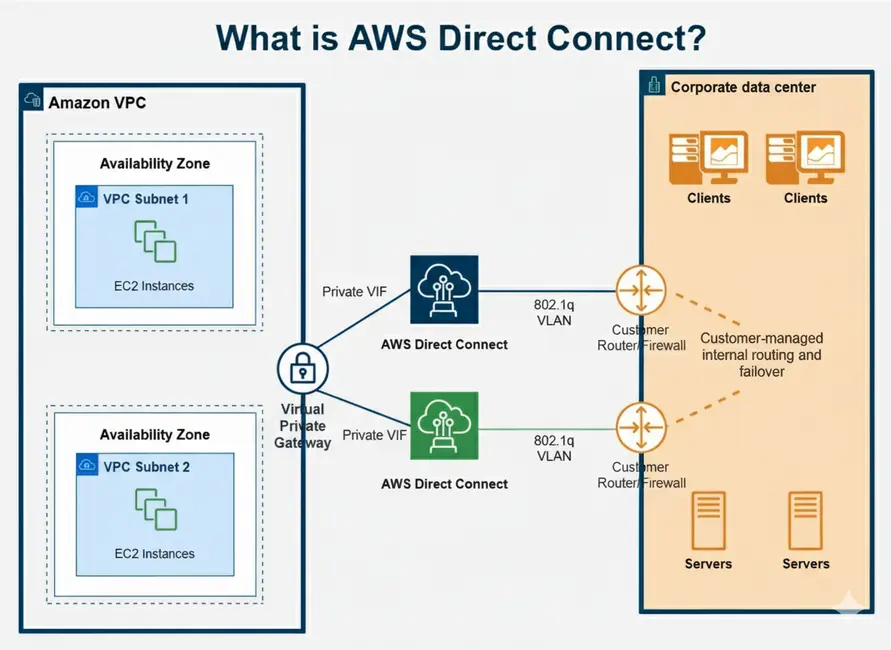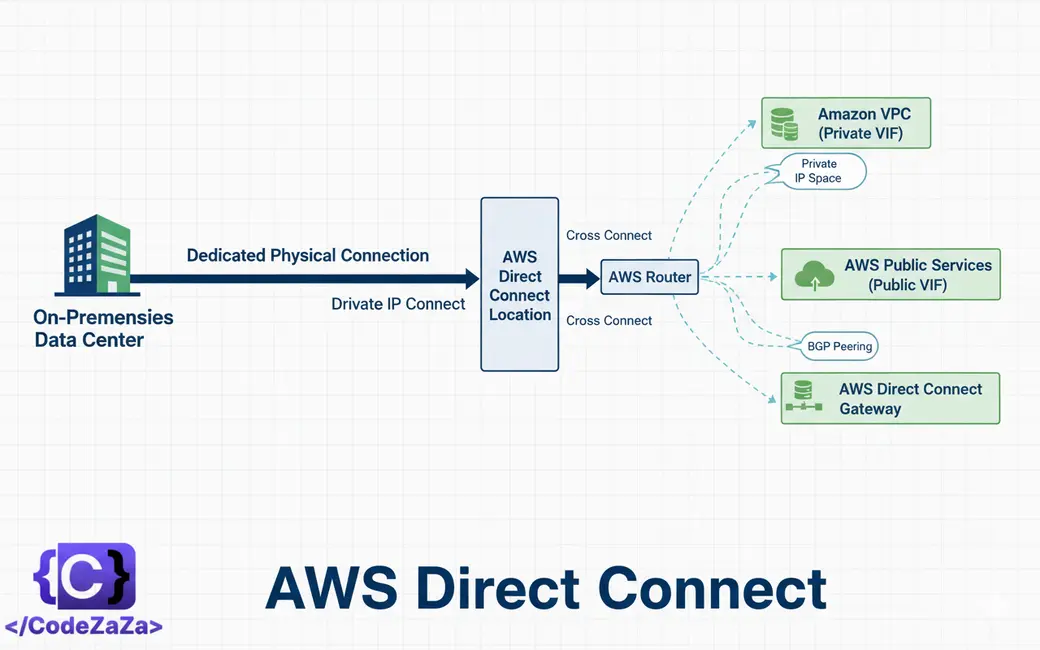AWS Direct Connect enables a direct, dedicated connection between your internal network and AWS, bypassing internet service providers for a faster, more secure link. This setup uses a high-speed Ethernet fiber-optic cable which connects directly from your network’s router to an AWS Direct Connect router at an AWS location. With this dedicated connection, you can create virtual interfaces to access AWS services, such as Amazon S3 or Amazon VPC in a streamlined manner.

What is AWS Direct Connect?
The AWS Direct Connect like a private highway that connects your office or data center directly to Amazon’s cloud (AWS).
Normally, when you use AWS services, your data travels over the public internet, which can be slower, less reliable, and less secure. With Direct Connect, instead of using the public roads (internet), your data uses a dedicated private lane (fiber-optic or Ethernet cable) straight to AWS.
This makes the connection:
- Faster (low delay/latency)
- More secure (not exposed to the public internet)
- More reliable (less chance of interruptions)
It’s especially useful for business-critical applications, big data transfers, or industries like finance and healthcare where security and speed are very important.
How Does AWS Direct Connect Work?
- Physical Connection → Your company sets up a fiber-optic or Ethernet cable from your office/data center to an AWS Direct Connect location (like an AWS building or partner network hub).
- AWS Router Link → That cable plugs into an AWS router, creating a private line between your network and AWS.
- Virtual Interface (VIF) → On top of that physical link, AWS sets up a virtual interface, which is like a digital handshake that lets your network talk securely to AWS services (like S3, EC2, or RDS).
- Direct Access → Now your apps and data can move between your network and AWS without touching the public internet, ensuring speed and safety.
Components of AWS Direct Connect
To understand how AWS Direct Connect works, let’s break down its main building blocks. These are the key components that make private connectivity between your office/data center and AWS possible:
1. Direct Connect Location
These are special physical data centers where AWS has set up Direct Connect facilities. To use Direct Connect, your company needs to connect to one of these locations (either directly or through a partner network provider).
Just like the “entry point” to AWS’s private highway.
2. Cross Connect
A physical cable inside the Direct Connect location that links your network equipment (like your router) to the AWS router.
This is like plugging in your private lane to the AWS highway.
3. Virtual Interface (VIF)
Once the physical connection is ready, AWS sets up a virtual interface on top of it. This is like a digital channel that determines how you connect to AWS services:
- Private VIF → Connect directly to your Amazon VPC (Virtual Private Cloud).
- Public VIF → Connect to AWS public services like S3 or DynamoDB over a private path.
It’s the “lane divider” telling your data where to go.
4. Direct Connect Gateway
This component allows you to connect your on-premises network to multiple VPCs across AWS Regions using the same Direct Connect link.
Instead of building separate highways for each VPC, the gateway acts like a hub that distributes traffic to many destinations.
5. Router / Customer Gateway
This is your on-premises router that connects your local network to AWS Direct Connect. It usually uses BGP (Border Gateway Protocol) for exchanging routing information with AWS.
Just like The “traffic controller” making sure your data finds the right path between your office and AWS.
Benefits of AWS Direct Connect

1. Private & Secure Connectivity
With AWS Direct Connect, your data travels over a dedicated physical link that bypasses the public internet entirely. This private connection is a game-changer for businesses that handle sensitive data or have strict compliance requirements. By eliminating the risks associated with public networks, you ensure your information remains secure and your operations stay protected.
2. High Bandwidth & Low Latency
Say goodbye to network bottlenecks! Direct Connect provides a range of high-bandwidth options, from 1 Gbps to 100 Gbps, allowing you to transfer large datasets quickly and efficiently. By reducing network latency, it’s perfect for mission-critical and latency-sensitive applications like real-time analytics, live streaming, or large-scale data migrations.
3. Seamless Integration & Scalability
AWS Direct Connect seamlessly integrates your on-premises infrastructure with a wide array of AWS services. This allows you to effortlessly extend your data center to the cloud, enabling hybrid cloud architectures and scalable solutions. Whether you’re using Amazon EC2, Amazon S3, or Amazon RDS, Direct Connect ensures a reliable and high-performing link.
4. Reliable Disaster Recovery
Protect your business from unexpected outages. Direct Connect is an essential component of any robust backup and disaster recovery strategy. It provides a fast, reliable, and secure path for data replication and failover, ensuring your business-critical operations can continue uninterrupted in the face of disaster.
5. Cost-Effective for High Data Transfer
While there’s an initial setup investment, AWS Direct Connect can lead to substantial long-term cost savings, especially for companies with significant data transfer needs. It offers predictable pricing and often provides lower data transfer rates compared to standard internet-based connectivity, giving you better control over your cloud spending
Use cases for Aws Direct Connect
1. Hybrid Cloud Architecture
AWS Direct Connect is essential for building a hybrid cloud environment, where you seamlessly connect your on-premises infrastructure to the AWS cloud. This allows you to extend your data center into AWS, enabling you to use cloud services for things like application development, testing, and burst capacity without migrating all your infrastructure at once. It ensures consistent, low-latency connectivity between your on-premises resources and your AWS Virtual Private Cloud (VPC).
2. Large-Scale Data Transfers
For businesses that need to transfer massive datasets to or from AWS, Direct Connect is a game-changer. It provides high-bandwidth connections (from 1 Gbps up to 100 Gbps), making it perfect for tasks like:
- Data migration: Quickly moving large databases or archives to the cloud.
- Big data analytics: Transferring large volumes of data for real-time analysis in the cloud.
- Media and entertainment: Ingesting and processing high-resolution video files.
By avoiding the public internet, you get more predictable transfer speeds and avoid bottlenecks.
3. Real-Time Applications and Workloads
Applications that are highly sensitive to network latency, such as live video streaming, real-time trading platforms, and online gaming, benefit significantly from Direct Connect. The dedicated connection provides a more consistent and lower-latency network path than the public internet, ensuring a better user experience and reliable application performance.
4. Enhanced Security and Compliance
Since AWS Direct Connect traffic doesn’t traverse the public internet, it significantly reduces exposure to potential security threats like distributed denial-of-service (DDoS) attacks. For industries with strict regulatory and compliance requirements (like healthcare and finance), this private connection ensures that sensitive data remains secure during transit, helping to meet compliance standards like HIPAA or PCI DSS.
5. Disaster Recovery and Business Continuity
Direct Connect provides a secure and reliable network link for disaster recovery (DR) and backup strategies. By establishing a dedicated connection between your on-premises data center and a remote AWS region, you can ensure fast, consistent data replication and failover in the event of an outage, minimizing downtime and supporting business continuity
Aws Direct Connect Pricing
AWS Direct Connect pricing is based on two main factors: port-hour charges and data transfer out (DTO) fees. Port-hour costs vary depending on the type of connection—dedicated or hosted—and the bandwidth you select, which ranges from 50 Mbps up to 100 Gbps. Hosted connections, provided through AWS Direct Connect partners, are often more affordable for smaller workloads. On the other hand, dedicated connections deliver greater capacity and reliability, making them ideal for enterprises running mission-critical applications.
For example, a 1 Gbps hosted connection is priced at about $0.33 per port hour. This equals nearly $240 per month, with data transfer charges added on top. Data transfer out is billed per gigabyte and varies based on the AWS Region and Direct Connect location. However, data transfer into AWS is always free.
As a result, this pricing model often proves cheaper and more predictable than internet-based VPNs. Moreover, by bypassing the public internet, businesses gain lower latency, improved security, and consistent performance. In short, AWS Direct Connect pricing is both flexible and scalable, helping companies balance cost efficiency with secure, high-performance cloud connectivity.
AWS Direct Connect Pricing Table
| Bandwidth Option | Port Hour Price | Approx. Monthly Cost (730 hrs) | Notes |
|---|---|---|---|
| 50 Mbps | $0.03 | ~$22 | Best for small workloads and testing |
| 100 Mbps | $0.06 | ~$44 | Suitable for light data transfer |
| 200 Mbps | $0.08 | ~$58 | Good for small business use |
| 500 Mbps | $0.20 | ~$146 | Balanced choice for growing apps |
| 1 Gbps | $0.33 | ~$241 | Common for enterprise workloads |
| 2 Gbps | $0.66 | ~$482 | Ideal for data-heavy applications |
| 10 Gbps | $2.48 | ~$1,810 | High-performance, mission-critical apps |
| 100 Gbps | Custom Pricing | Contact AWS | For large enterprises & data centers |
Conclusion
AWS Direct Connect is a powerful solution for businesses that need secure, reliable, and high-performance connectivity between their on-premises infrastructure and AWS. By bypassing the public internet, it provides private connections, reduced latency, and predictable network performance—making it ideal for mission-critical workloads, hybrid cloud setups, and backup and disaster recovery strategies.
While there is an initial setup cost, the long-term savings, improved security, and seamless integration with AWS services make Direct Connect a smart investment for organizations with significant cloud usage and data transfer requirements.


